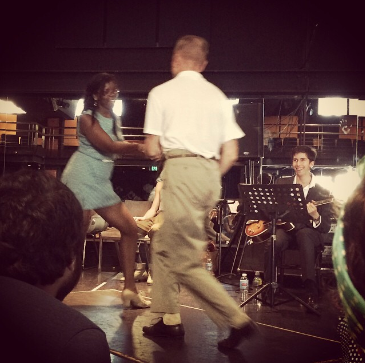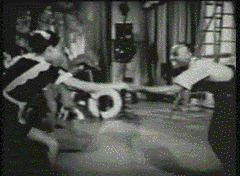I’ve started my own dance business, Swing Dance Sydney, and I’m looking into various legal and financial guidelines for running this sort of business.
So far I’ve discovered some very interesting things. The least surprising of which is that most Australian lindy hop teachers aren’t operating under safe or even legal conditions. Not that surprising, right? When I started looking at this stuff, I was a bit nervous, because I’d been led to believe that all this stuff is really complicated.
It’s not.
It’s really easy to set up your own dance business, and run it legally and safely, and there are lots of great free resources to help you.
Key areas to consider:
Business Name
Registering a business name. It’s easy. You need a tiny bit of money, a name, and a bank account. Boom. Done.
Business Structure
You’ll need a business structure: will you be a sole trader? An incorporated company? A non-profit? Each makes different demands, and some are simpler than others. There are advantages to some (eg non-profits have access to supercheap community venue hire; sole-traders are really simple to set up – the easiest), and disadvantages to others (non-profits are quite complicated and require AGMs, a minimum number of executives, etc).
Contracts and/or Agreements
If you are working with other people – ie DJs, a teaching partner, a venue, a visiting teacher, another teaching team in your school or business – you will need to have either contracts or agreements. These shouldn’t be verbal. They should be written down. A written agreement has quite a lot of power, and is really important for helping you keep track of who needs to be paid what and when, what you all expect of each other, who should be doing what work, and when it all needs to happen.
I already use written agreement with DJs: I write DJ briefs. I’ve explained why I take a professional approach to managing DJs in this post, where I make it clear that being a professional employer not only helps you run top shelf events, it also helps you run equitable events and secures diversity. In other words, if you don’t do things like a pro, we’ll be able to see it, because you won’t have any women DJs in your team.
A sample copy of my DJ brief:
Page 1
Page 2
I can send you and editable version if you like. And as you can see, I’ve cut out my phone number and the name of the event from this version. I try to take a light hearted tone in these things, because I’ve found DJs can get bloody huffy if you preach at them. I often add a ‘brown M and M clause’ to my briefs to check and see who’s read it. This is often a photo of a pony.
I also use a very brief brief :D with bands, where I lay out the basics. I sent this one last week to the leader of a band I’m hiring this week:
Hi [band leader name],
Just checking in to see you’re ok at your end for this gig.
Now that I’m past the big October weekend, I’ll start ramping up the promotions, so you may get a bit of spam on facebook – just turn off notifications in the event settings if you don’t want them.
Please let me know how many mics you’ll need, so I can sort that out.
We won’t have a sound guy, which will be a pain sometimes, but we can be casual at this gig, as it’s a smaller crowd. And there tends to be a lot of audience/musician interaction at these gigs as well, which is nice.
I’ll pay you $[pay rate] on the night, before the gig, and put a tab on the bar and in the kitchen for your drinks and food. The kitchen does good vegetarian stuff, but let me know if anyone needs vegan/wheat free.
Make sure you bring CDs to sell! We can handle that at the door for you.
And do let me know if you want some friends put on the door.
Just to double check the running order for the night:
5.30 venue opens, and we can do the bump in. I’ll arrive to do the set up.
6.30 we have a dance class, so we’ll need to have the band bumped in by then (you can eat dinner in this spot, or later or earlier!)
7.30 the class ends, so you can begin, though we can just pipe in some DJed music if you want to start at 8pm (we can be casual about timing)
8.10 band break 1 (if you start at 7.30)
8.30 band set 2
9.10 band break 2
9.30 band set 3
10.00/10.10 finish
10.30 the venue has a sound curfew, so we’ll need to have the sound finished by then.
Thanks, and see you in a few weeks!
Sam.
Sometimes when I write these, I feel a bit uncomfortable for being such a stickler for formalities. But over the years my experience with organising DJs and volunteers, working with venues, hiring teachers and sound engineers, and even just sorting out dance troupes’ performances at a regular dance have made me realise that you do need to set all these things out clearly. It’s when you don’t state things clearly that a) people fuck up, b) there are misunderstandings that make people ANGRY, c) you get screwed over, d) people try to bully you into doing stuff you don’t want to do. If someone objects to an agreement like this, I don’t work with them. Flat, that’s my rule: you don’t accept this agreement, it’s not on.
As an organiser, it helps me to have a summary of a negotiation or bargaining process, and it also helps all of us stay on the same page. I have had people try to renege on these deals, and I have had people try to bully me into not using these agreements, or into deviating from them. No. I won’t do that. There’s quite a bit of bullying in the lindy hop world, and I have zero tolerance for it.
It turns out that you’re legally required to have these agreements when you run businesses in the arts. UNSURPRISE.
The Arts Law Centre of NSW provides templates for agreements on their website, which is fantastic: it can help you figure out how you should word things so everyone is protected, legally.
Tax
If you pay people or deal with people in situations where money changes hands (that’s you, dance people), you’ll need to think about tax (income tax, GST, etc).
Most dance business won’t need to worry about GST. You don’t have to collect if it your net income is less than $75000 per year (ATO reference). So you don’t need to deal with BAS forms or any of that rubbish, in most cases. Easy.
Contractors, Employees, and their ABNs
If you’re paying people, they’ll need to be a) employees, or b) contractors. If they’re contractors, and businesses themselves, you’ll need to collect their ABN. If they don’t have one, you can have them sign a non-declaration of ABN form (technically a ‘Statement by a supplier (reason for not quoting an ABN to an enterprise)’ form: ATO reference.) This is cool, and applies to most of us doing day-to-day work in the dance world: if you’re a hobbyist (ie this isn’t your main job), or if you’re being paid less than $75 for the work.
But what if they’re a band, and you’re paying them more than $75? Then they’ll need to give you their ABN. If they don’t, you have to withhold (and pay!) up to 46.5% of the value of the pay – as a non-declaration tax! EEEK! So, bands: get an ABN.
Insurance, Workers’ Compensation and OH&S
If you are dealing with the public, you’ll need insurance. This sounds tricky, but it isn’t, really. You can organise public liability insurance for your dance school for $300 or less with one phone call, effective within 24 hours.
Once again, there are approximately one million great resources for dealing with this stuff.
Public liability
The most basic insurance you’ll need is public liability insurance. This protects you from other people’s legal action, and nothing else.
Accident Insurance
You can also insure your students against accident, for a reasonable rate (about $4 per student per year, which you can absorb if you’re a club and the students are paying annual fees). You can also insure your teachers against accident.
Work Cover and Workers’ compensation
Ok, this is where we need to kiss the unions right on their faces for a) all this wonderful stuff, and b) also providing fantastic information about doing the right thing by your workers.
Firstly, who counts as a worker?
Anyone you pay money to. So teachers in your school, DJs or bands at your dances, sound engineers at your gigs. And even, conceivably, volunteers who receive payment in kind (ie free entry). So if you’re running a party or teaching classes with someone, you need to think about this stuff.
If you are paying workers (whether employees or contractors), and you are paying all of them more than a total of $7500 per year, then you MUST have Work Cover.
[EDIT: this doesn’t apply to you if you’re a sole trader – only pty ltd companies need to consider work cover. If you have questions about this, give Work Cover a call – their numbers are on their websites, they’re very nice, and each state is different.]
If an employer pays workers more $7500 per year in total for all wages, (in this next bit I draw and quote directly from WorkCover):
…they are required by law to have a workers compensation insurance policy (Work Cover ref)
In the event of a workplace injury or disease, the insurance policy will provide the worker with weekly benefits, medical and hospital expenses, rehabilitation services, certain personal items (eg. clothing and spectacles, if damaged in a work-related accident), and a lump sum payment for permanent impairment.
An employer is a business (including an individual) that employs or hires workers on a full-time, part-time or casual basis, under an oral or written contract of service or apprenticeship (Work Cover reference).
Occupational Health and Safety
As an employer, you have a duty of care to your workers. These involve a number of things, summed up as a) keeping the workplace safe; b) educating workers about safety; c) documenting injuries, d) reporting injuries; e) actively working to prevent injuries.
So let me make that clear: if someone has an accident at your dance or in your class or at your event, you are LEGALLY REQUIRED to make a record of it.
After all this fun stuff, you’ve really only got two other important things to do: get a PR strategy happening, and make a business plan. Which are the fun bits!


